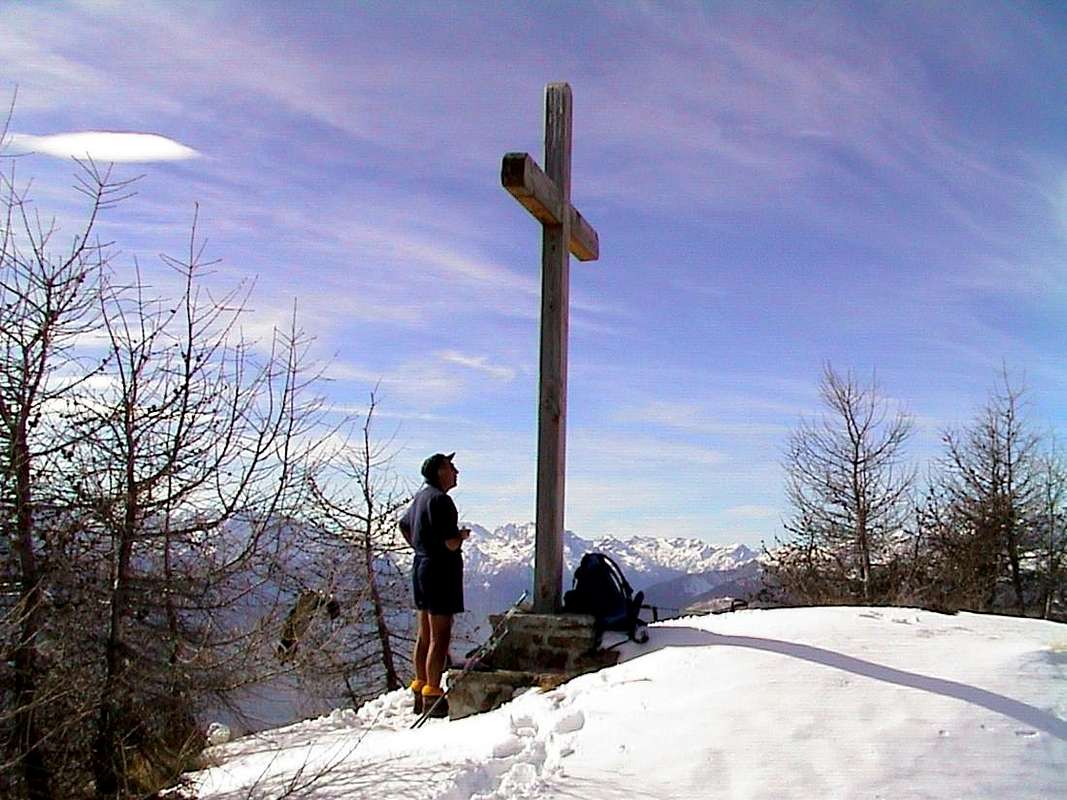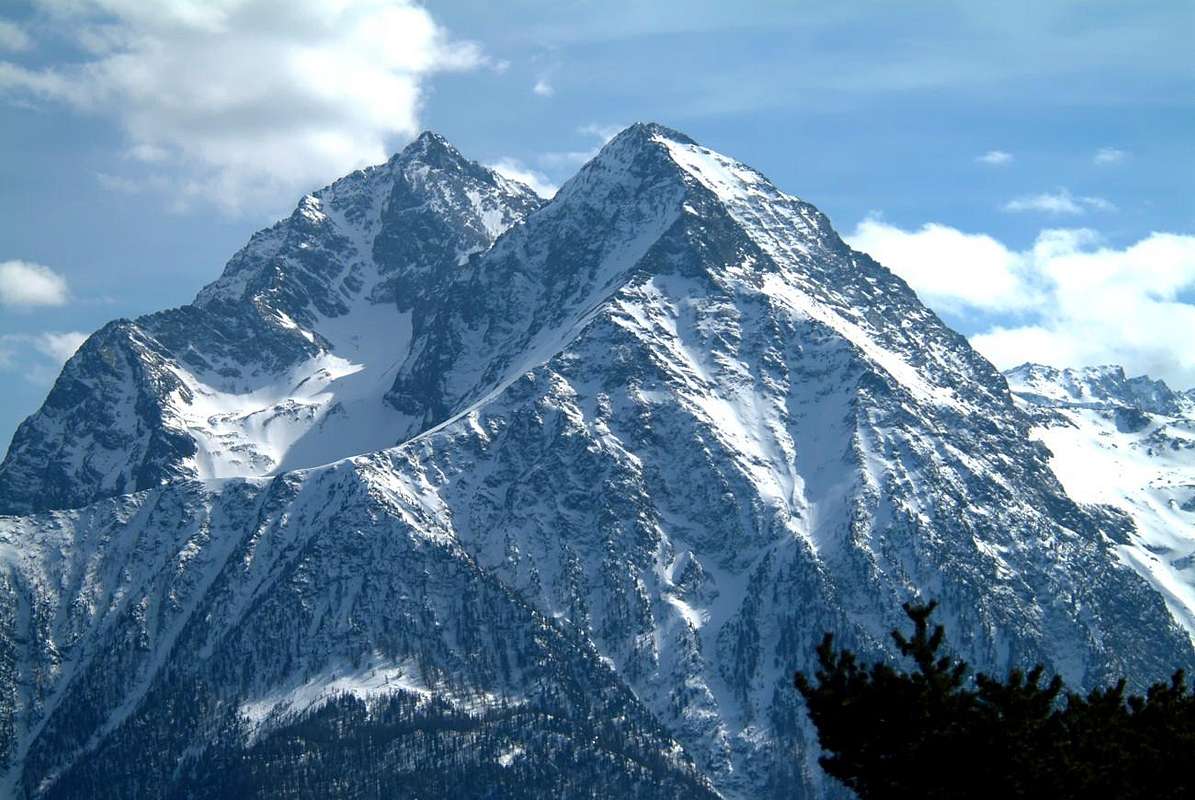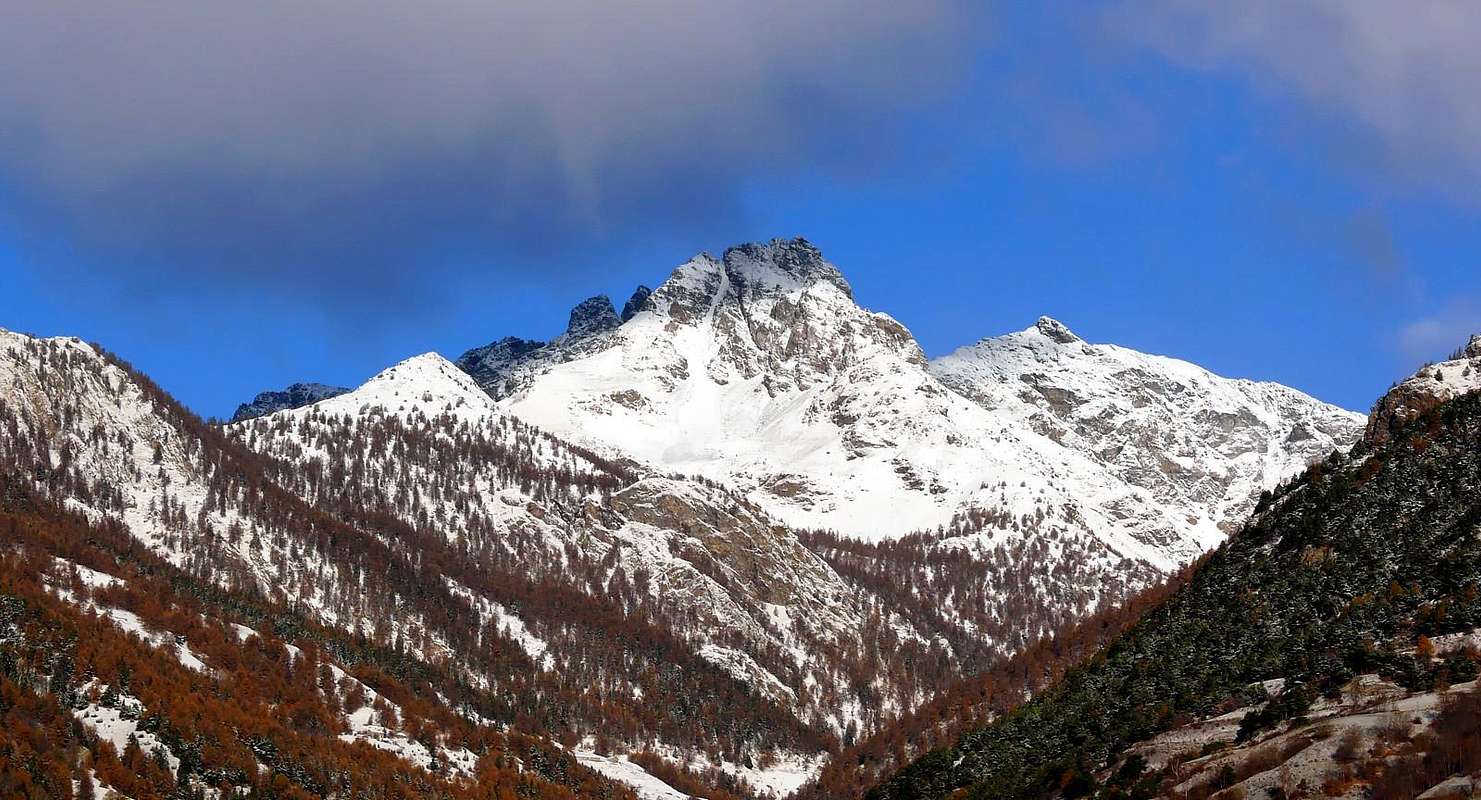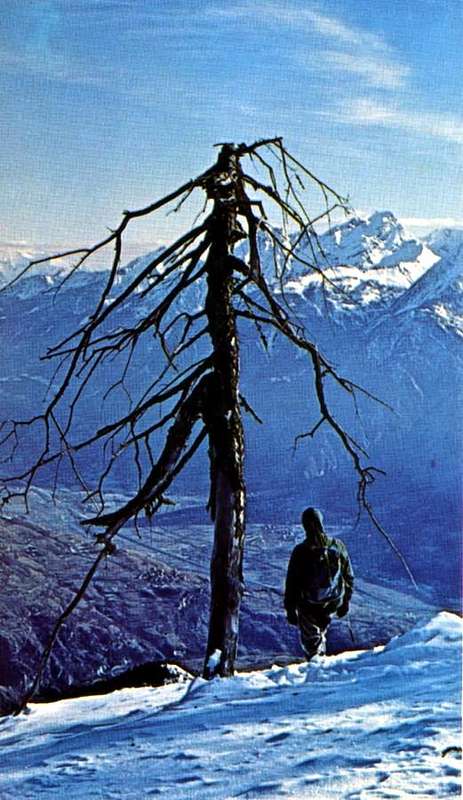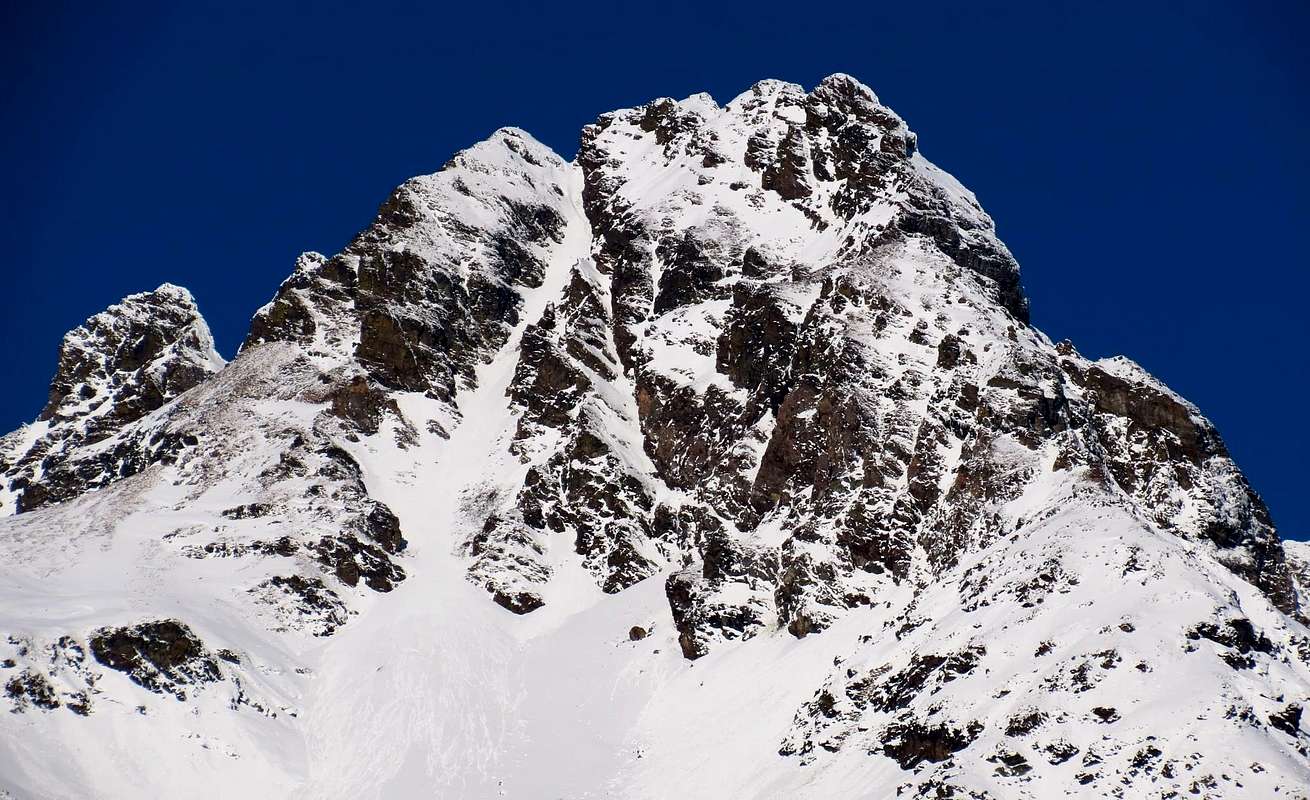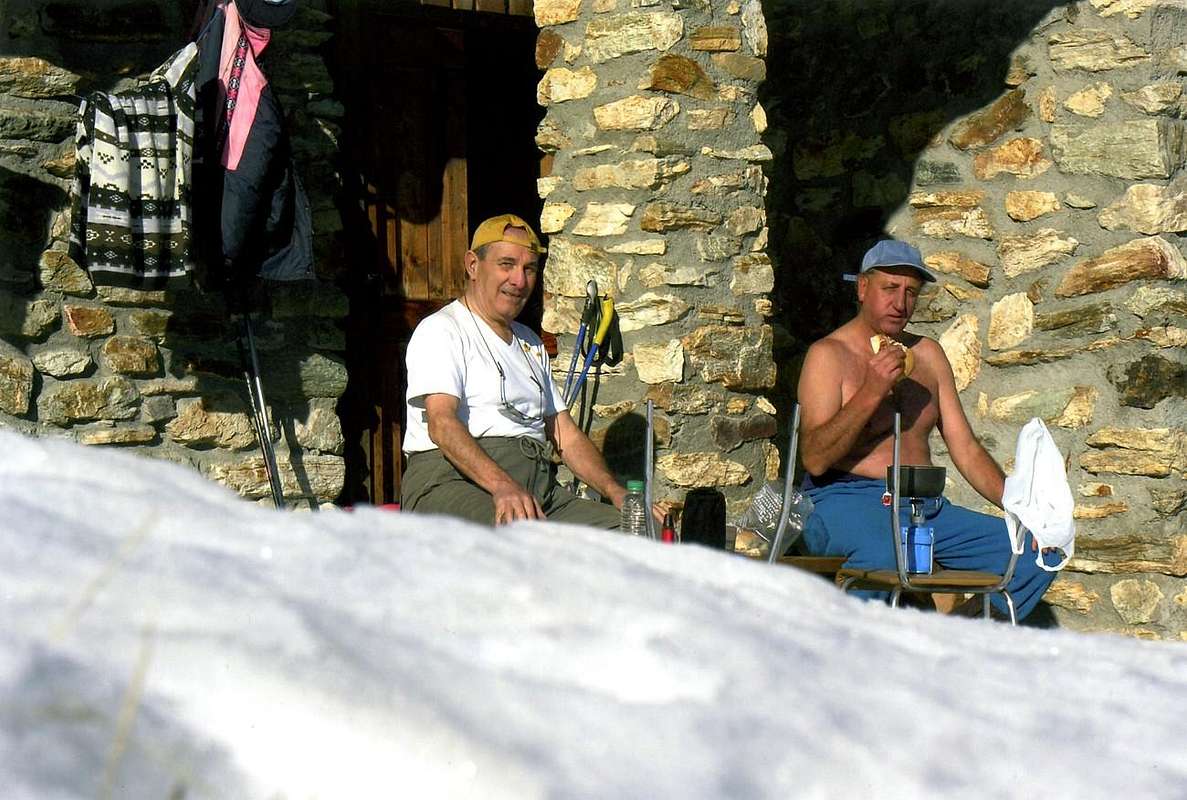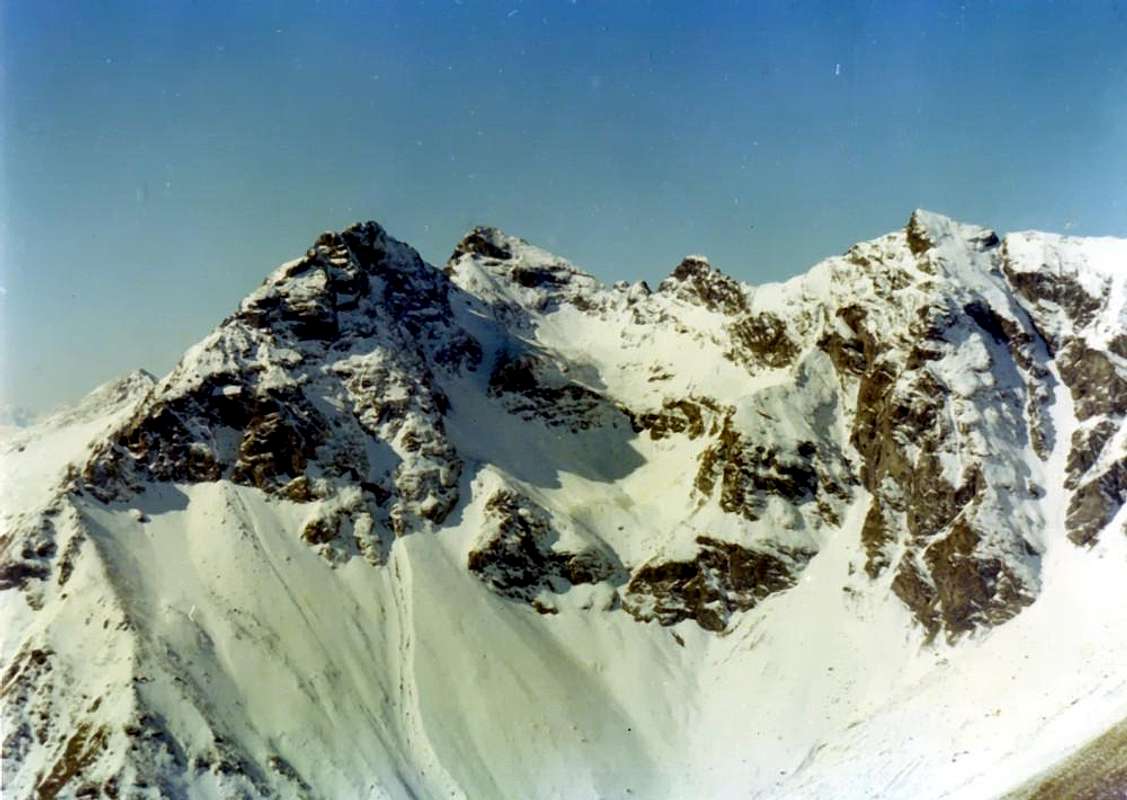Quando Voi Gente vedete salir la Croix de Fana significa che Primaver sta per arrivar. La Croce, rivolta a Sud, afferra i primi raggi del sole ad Oriente e li deposita nel tardo pomeriggio ad Occidente, verso il Monte Bianco e la sua enorme Catena, che da questo grande
ben si vedono all'orizzonte. Al di sotto la Città di Aosta già dorme e solo il nastro d'argento della Dora Baltea si disegna tra le mille luci che s'accendono con l'arrivo della Notte. Una linea perfetta di montagne traccia un grande profilo in contrasto col Cielo, come un'oscuro serpente che s'allunga da Est ad Ovest. Anche i venti, qui generalmente impetuosi, improvvisamente taccion e la vipera incomincia a dischiudere le sue uova. Ad ogni nuova Alba troverete che la neve sfugge sempre più in alto, dando ampi spazi ai prati che iniziano a rinverdire. Per primi, come per tutti le altre balconate della Valle rivolte al Mezzogiorno. Quando in quel mattino dell'Epifania 1969 salivamo verso Trois Villes con la Mini Minor, colore carta da zucchero, di Ilario le condizioni, più o meno, erano queste. L'Inverno era in ritardo e noi volevamo approfittarne per cercare d'effettuare la prima salita invernale alla Tsaat à l'Etsena; partivamo da qui non esistendo ancora la strada poderale per la Comba di Senevé. Un approccio molto lungo che, raggiunta la Croix de Fana e percorso tutto lo spartiacque insino al Passo Alto (
; allora senza nome) sotto i Becchi di Fana, avrebbe permesso con una discesa in diagonale di portarci alla base del gran canale che risale al Colle di Fana, tra i Becchi e la Punta Est di Tsaat. Salire alla Croix fu una passeggiata e non la ricordo nemmeno, intenti com'al solito, durante gli avvicinamenti, a chiacchierare facendo progetti. Ma giunti sulla Sommità, in un mattino freddo con il cielo striato da gelide linee bianche, ci accorgemmo che proseguire a Nord sulla cresta era cosa impossibile: ad ogni passo si affondava sempre di più nella neve alta che le ultime nevicate ed il vento avevano incorniciato sul crinale. Una brutta sorpresa perché non avevamo racchette da neve ed il solo Ilario portava, legati sopra lo zaino, un paio di sci Anni Trenta. Due tavole di legno con una enorme punta rivolta allo in sù (come si vede nelle vecchie foto per gli sci finnici) ed un arrugginito attacco Kandahar.
. Altro che Tsaat! La stessa ci guardava beffarda tra un turbinio di neve avvolgente le sue due Sommità: l'Uomo propone e la Montagna dispone ... Che fare? Beh, intanto si fanno due foto e poi si mangia perché st'aria fredda fa venire un certo languorino! Poi vien l'ora d'andar giù ed ad Ila viene in mente un'idea balzana: scendere direttamente con gli sci sul ripido Versante Sud in mezzo a blocchi, rocce rotte, cespugli ed alberi. Guardo abbasso: cose da matti con quelle due tavole secche! Ma lui che cerca una emozione giornaliera (a quei tempi non si parlava ancora di astinenza da adrenalina) non ci pensa due volte e si butta giù. Con grandi colpi d'anca a far curve, mentr'io rimango apprensivo, in un attimo arriva al plateau dabbasso. Non resta che raggiungerlo per la via di salita passando attraverso una scheletrica e pietrificata foresta, con le neve che non é più quella del mattino perché il sole l'ha trasformata e si affonda fino alle ginocchia ed anche di più ... Ho voluto scrivere di questa gita di quarantacinque anni orsono solo con la Memoria per poi farne il confronto con quanto scritto nei nostri Diari Alpinistici; é abbastanza divertente vedere come vengano contraffatti i ricordi. Pareva che in un attimo fossimo rientrati alla base e che la salita era priva di neve;
" ... ben presto però ci accorgiamo che se ci sarà dato di arrivare alla Croix (che allora chiamavamo Croux in un idioma erroneo, misto tra italiano, francese e patois) sarà già tanto, tanto la neve é alta e molle. Infatti "nuotando" e strisciando alle 11,15', con un vento freddo e forte, siamo presso la croce. Ci sediamo dietro ad una gobba di neve che ci ripara dal vento e dal freddo e, contenti della nostra piccola vittoria, nel giorno dell'Epifania godiamo del pallido sole che avvolge i monti lucenti sopra la foschia della valle." E da quello di Ilario:
; cose da studi psicologici o da neuro. Questa é stata la prima Croix de Fana, che ci lasciò però la amara convinzione che non avremmo mai realizzato la prima invernale alla Tsaat. Troppo lontana da avvicinare e di inverni ce ne sono anche di peggiori. Invece il Tempo é galantuomo e negli anni successivi la realizzai a tutte e due le Sommità, nonché a tutte le altre di questa piccola catena che inizia ad Ovest con la Becca di Viou. Non con Ilario, che purtroppo nel fine di Settembre dello stesso anno morì, ma con altri compagni che il Destino ti porta ad incontrare. Nel frattempo andare alla Croix era diventata una usanza di inizio stagione per compiere un buon allenamento, per la qual cosa le salite a questa montagna diventarono una tradizione con itinerari diversi su tutte le creste ed i suoi versanti.
Some information or simple tip we can give you about it this easy hike but sometimes has some unknown:
a)- do not be attracted by the direct ascent on the North Slope, as well as boring and tiring;
b)- instead use the handy marked trail that starts at the small parking lot Fonteil, climb diagonally toward the Northwest and then, turning gradually to the north, reaching the "Crestone" Southeast and is crossed by an ancient forest "petrified" quietly leads Westward to the plateau below the Summit. If you want to continue through the Dèche Comba, further East, follow the path next, always reported, which with a first initial steep ramp detaches itself from the private road;
c)- but if there is still snow should follow this with a longer ride to the inside of the Comba to Flemagne Pasture
(1709m) and this fall in the opposite direction towards the "ridge". Otherwise
d)- in the case of deep snow use this path, quite safe from snowslides by means of snowshoes; last hypothesis
e)- if the snow is too high should discard this route and follow the previous year. If you want to climb through the Senevé Basin
f)- go to the alp of the same name by the farm road and then not numbered with small path, which starts from the Higher Alp Champchamossin
(1851m), through the forest towards Southeast on Western Slope; in this case, here coming downhill on the contrary, absolutely avoid crossing the forest to the South and East (above the Valseinte) then to reach the "terrace", where perhaps you left the car. The path between bushes, brambles and unstable blocks is dangerous due to the presence of the viper, as well as boring and tiring (personal and unique experience). Finally, if you want to reach the Summit from the North,
g)- continue on the private farm road to the junction at the Alpe Lattaz
(1935m) or the next Senevé; from these a good path numbered, but difficult to identify in the first part, up to the Col Cornet
(2280m) and with this easy crossing to the South you reach easily the Cross, after a short descent. This path must not have snow, or at least it should be very low and scarce level. This hill can be reached
h)- also by Comba Dèche: Flemagne to continue along the farm road up to the Pastures of Brunier
(1771m) and Clavel
(1994m); from this reach the junction
around 2020/30 metres just before the La Seyvaz Alpage
(2184m), from where a path to the South-southwest unnumbered rising through the foothills of the Eastern Becchi of Fana; crossed the great Eastern Ridge of these and crossed a creek secondary, the same, which becomes a small track, reaches the collar. This diagonal via food must be covered in the beginning of the season, because it is very exposed to avalanches from Beaks of Fana, Punta Maria Joseph Henry and Becca Conge (
see photo).
![]() From Fana Beaks up to the Becca Conge above Comba Dèche, from East-northeast
From Fana Beaks up to the Becca Conge above Comba Dèche, from East-northeast
Qualche ragguaglio o semplice suggerimento possiamo darVi al riguardo di questa facile escursione che però a volte presenta qualche incognita:
a)- non lasciatevi attrarre dalla salita diretta sul Versante Sud, perché noiosa e pure faticosa;
b)- usate invece il comodo sentiero segnalato che, partendo presso il piccolo parcheggio di Fonteil, sale in diagonale verso Nordovest per poi, piegando progressivamente a Settentrione, raggiungere il "Crestone" Sudest ed, attraversata un'antica foresta "pietrificata", tranquillamente conduce verso Ovest al plateau sotto la Sommità. Se volete continuare tramite la Comba Dèche, più ad Est, seguite il sentiero successivo, sempre segnalato, che con un prima ripida rampa iniziale si distacca dalla strada poderale;
c)- se però vi é ancora neve conviene seguire questa con un giro più lungo all'interno della Comba fino all'Alpe Flemagne
(1709 m) e da questa rientrare in senso opposto verso il "crestone". Altrimenti
d)- in caso di neve alta utilizzare questo percorso, abbastanza al riparo dalle slavine, per mezzo delle racchette da neve; ultima ipotesi
e)- qualora il manto della stessa risulti troppo alto conviene scartare quest'itinerario e seguirne il precedente. Se si vuole salire tramite la Comba di Senevé
f)- proseguire verso l'omonima alpe tramite la strada poderale e poi con piccolo sentiero non numerato, che parte dall'Alpe Champchamossin Superiore
(1851 m), attraversare verso Sudest il boschivo Versante Occidentale; in questo caso, qui arrivando al contrario in discesa, assolutamente evitare di attraversare la foresta verso Sud e poi Est (al di sopra della Valseinte) per raggiungere il "terrazzo", dove magari avete lasciato il mezzo. Il percorso tra cespugli, rovi e blocchi instabili é pericoloso per la presenza della vipera, oltre a che noioso e faticoso (personale ed unica esperienza). Infine se volete raggiungere la Sommità arrivando da Nord,
g)- continuare sulla strada poderale fino al bivio presso l'Alpe Lattaz
(1935 m) o la successiva di Senevé; da queste un buon sentiero numerato, ma difficile da individuarsi nella parte iniziale, sale al Col Cornet
(2280 m) e da questo con facile traversata verso Sud si raggiunge agevolmente la Croce, dopo una breve discesa. Questo percorso non deve presentare neve, od almeno la medesima deve risultare molto scarsa e di bassa entità. Questo colle può essere raggiunto
h)- anche dalla Comba Dèche: da Flemagne continuare lungo la strada poderale fino agli Alpeggi di Brunier
(1771m) e Clavel
(1994 m); da questo raggiungere il bivio
2020/30 metri circa poco prima dell'Alpe La Seyvaz
(2184 m), dove parte verso Sud-sudovest un sentiero non numerato che sale attraverso le pendici Orientali dei Becchi di Fana; oltrepassato il grande crestone Est di questi ed attraversato un torrente secondario, il medesimo, che diventa una piccola traccia, raggiunge il colletto. Questa via diagonale non deve essere assolutamente percorsa in inizio di stagione, perché molto esposta a valanghe (
vedi foto).
Comments
No comments posted yet.
